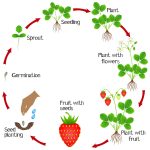Strawberry plants are a delightful addition to any garden, offering sweet and juicy fruit for you to enjoy. However, like any plant, they require maintenance and care to thrive. One question that often comes up for gardeners is how often strawberry plants need to be replaced. Let’s delve into this topic to understand the factors affecting the lifespan of strawberry plants.
Factors Affecting the Lifespan of Strawberry Plants
Several factors influence the longevity of strawberry plants:
- Variety: Different varieties of strawberries have varying lifespans. For instance, June-bearing varieties typically produce fruit for 2 to 3 years before their production declines, while everbearing varieties may continue to bear fruit for 3 to 5 years.
- Soil Quality: The health and fertility of the soil play a crucial role in the longevity of strawberry plants. Proper soil preparation, including pH adjustment and nutrient enrichment, can support the plants’ vigor and lifespan.
- Disease Resistance: Disease-resistant varieties and proactive disease management can extend the lifespan of strawberry plants by preventing common diseases that may otherwise shorten their productive years.
- Climate: The growing conditions in your region, including temperature, humidity, and sunlight, can impact the lifespan of strawberry plants. Adequate environmental conditions support the plants’ vitality and longevity.
- Care and Maintenance: Proper care, including regular watering, feeding, and timely removal of runners, can significantly contribute to the prolonged lifespan of strawberry plants.
When to Replace Strawberry Plants
Considering the factors mentioned above, the decision to replace strawberry plants depends on various indicators:
- Decreased Yield: If the plants have significantly reduced fruit production despite optimal care, it may be an indication that their productive years are coming to an end.
- Poor Plant Health: Plants showing signs of disease, deterioration, or weakness may need to be replaced to maintain the productivity and vitality of the strawberry patch.
- Aging Plants: As strawberry plants age, their vigor and productivity naturally decline. Keeping track of the plants’ age and productivity can help determine when it’s time for renewal.
Resurgence Options
After determining that your strawberry plants need replacement, you have several options to ensure a thriving strawberry patch:
- Replacing Individual Plants: If only a few plants are struggling, you can replace them with new, healthy ones while maintaining the remaining productive plants.
- Renewing the Entire Patch: If a significant portion of the strawberry patch is underperforming or showing signs of decline, consider renewing the entire patch by replacing all the plants.
- Rotating Varieties: Introducing new varieties with different lifespans can help diversify the productivity timeline, ensuring a continuous harvest over several years.
Credit: www.quora.com
:max_bytes(150000):strip_icc()/Strawberryplant-GettyImages-123533002-5b198b33eb97de0036be58ae-d5982c5730984563a32598ee2a96fe3e.jpg)
Credit: www.thespruce.com
Frequently Asked Questions On How Often Do Strawberry Plants Need To Be Replaced
How Often Do Strawberry Plants Need To Be Replaced?
Strawberry plants typically need to be replaced every 3 to 5 years.
Why Do Strawberry Plants Need To Be Replaced?
Strawberry plants need to be replaced to maintain their productivity and vigor. Over time, plants may become less productive and more susceptible to diseases. Replacing them ensures a continuous supply of healthy and productive plants.
What Are The Signs That Indicate Strawberry Plants Need To Be Replaced?
Yellowing leaves, reduced fruit production, and stunted growth are common signs that indicate the need to replace strawberry plants. Additionally, the presence of diseases or pests can further indicate the need for replacement.
How Can I Ensure The Longevity Of Strawberry Plants?
Proper care and maintenance can help extend the lifespan of strawberry plants. Regularly check for pests and diseases, provide adequate water and ensure proper drainage, and remove old or damaged leaves to promote healthy growth.
Conclusion
In conclusion, the frequency of replacing strawberry plants depends on various factors such as variety, soil quality, disease resistance, climate, and care. Observing the performance and health of the plants can guide you in determining when to replace them. By understanding the indicators and available options for renewal, you can maintain a vibrant and productive strawberry patch for years to come.

I am a graduate of Bangladesh Agricultural University, where I delved into various agricultural disciplines, equipping me with a profound understanding of agriculture. Beyond academics, I have hands-on experience in gardening and crop cultivation. My passion is to embrace sustainable farming and horticulture. With a BSc in Agriculture, I am dedicated to promoting environmentally conscious and efficient agrarian practices.
Bachelor of Science (BSc) in Agriculture (Hons.)
Master of Science. (Sustainable Agriculture & Food Security ) (MS)
Bangladesh Agricultural University




